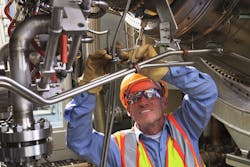You probably know “that guy who can fix anything.” Maybe he’s an uncle or your neighbor. Maybe you are that person. How does a person happen to have that ability? What if everyone in your maintenance department had that ability?
People who can fix anything share certain characteristics, such as the person:
- Is well-founded in the basics. He or she understands the “why” behind the “what.” You can’t do that by relying on Youtube videos or smartphone searches.
- Has a mathematical mindset, with the ability to think algebraically, trigonometrically, and geometrically. These three areas of intermediate math are useful ways of thinking.
- Takes a methodical approach to every task.
- Plans and then executes, rather than the other way around.
- Takes the time to identify and understand the question or problem at hand.
- Doesn’t fall prey to “all you see is all there is,” but seeks out additional information relevant to the problem.
About the Author

Mark Lamendola
Mark is an expert in maintenance management, having racked up an impressive track record during his time working in the field. He also has extensive knowledge of, and practical expertise with, the National Electrical Code (NEC). Through his consulting business, he provides articles and training materials on electrical topics, specializing in making difficult subjects easy to understand and focusing on the practical aspects of electrical work.
Prior to starting his own business, Mark served as the Technical Editor on EC&M for six years, worked three years in nuclear maintenance, six years as a contract project engineer/project manager, three years as a systems engineer, and three years in plant maintenance management.
Mark earned an AAS degree from Rock Valley College, a BSEET from Columbia Pacific University, and an MBA from Lake Erie College. He’s also completed several related certifications over the years and even was formerly licensed as a Master Electrician. He is a Senior Member of the IEEE and past Chairman of the Kansas City Chapters of both the IEEE and the IEEE Computer Society. Mark also served as the program director for, a board member of, and webmaster of, the Midwest Chapter of the 7x24 Exchange. He has also held memberships with the following organizations: NETA, NFPA, International Association of Webmasters, and Institute of Certified Professional Managers.
